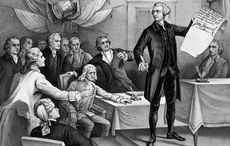It's an unending source of Hibernian shame that folks with names like Hannity, Conway, Kelly, and O’Reilly have made a name and a buck for themselves either bashing today’s immigrants or defending a president who views poor folks born elsewhere as a virus.
So it was refreshing to read through a new, much-discussed book about that strangest of mythical creatures, something these days that might seem akin to the Loch Ness monster or a unicorn—an Irishman who actually, even publicly, defended immigrants!
This is something of a lone bright spot in what is an excellent, insightful but also depressing book called "The Guarded Gate: Bigotry, Eugenics and the Law That Kept Two Generations of Jews, Italians, and Other European Immigrants Out of America," by Daniel Okrent.
Though some might also take comfort in the fact that the anti-immigrant hysteria emanating from certain quarters these days is not really new.
The new thing is that the grandchildren of the victims of this past anti-immigrant hysteria are among those spreading the hate. Folks with names like Hannity, Conway, Kelly, and O’Reilly. And Giuliani, Scaramucci, and Pirro. And Rosenstein, Kushner, and Mnuchin.
Read more: Historian wonders why Sean Hannity and conservative “loudmouths” are all Irish
So let’s go back to a simpler, more innocent time, when the folks who hated Irish Catholics and Italians and Jews were fusty old WASPs and the mad pseudo-scientists who provided a brand new rationale for anti-immigrant sentiment - and also put ideas into the head of a fledgling artist named Adolf Hitler.
This is the breadth and scope of the story told by Okrent, the title of whose book refers to an ugly poem by Thomas Bailey Aldrich, published in the august Atlantic Monthly in 1892—the very same year Ellis Island officially opened.
Aldrich’s verses (“Wide open and unguarded stand our gates/And through them presses a wild motley throng/... In street and alley what strange tongues are loud/Accents of menace alien to our air...”) reflect the deep anti-immigrant sentiment of an era when as many as a million immigrants were entering the U.S. annually.
Most of them, of course, were Catholics and Jews, many from southern and eastern Europe. Easily forgotten here is that Irish Catholics were still coming by, well, the boatload. Over 655,000 Irish came to the U.S. in the decade leading up to the opening of Ellis Island, with nearly 400,000 coming after its opening.
The Irish did have an advantage that Greeks, Slavs, Italians, and others “new” immigrants did not have—an established network of religious and political influence created in the wake of the Famine.
But that’s precisely what the bigots Okrent writes about resented about the Irish. That, of course, and their religion.
A Boston school board member named Joe Lee declared “the Catholic Church a great evil,” while another upstanding WASP named Prescott Hall grew so fed up he bellowed, “To hell with Jews, Jesuits, and steamships.”
Into this cauldron of rage ventured James Michael Curley, son of Galway immigrants and pride of Boston’s Irish political machine, who loved nothing more than to outrage the elites.
In 1913 Curley, a congressman and Boston mayor served as the head of the National Liberal Immigration League. Okrent writes of one lobbying trip to the White House when Curley “brought in witnesses representing organizations of Italian…Finnish…Polish and many other nationality groups.”
You know, back in the good old days when immigrants shed their identity and assimilated immediately.
Ultimately, Curley’s defense of immigrants was not enough. America built a big, beautiful wall around Ellis Island in 1924, cutting back on immigration drastically.
“Scientific” arguments that certain people were simply inferior were too persuasive to too many people. Including the Nazis in Germany, who pointed to American Eugenics as they devised their plan for a master race.
If only Okrent’s book were merely about the past.
Do you think that Irish Americans and Americans, in general, ignore the fact they all have immigrant ancestors? Let us know your thoughts in the comments section below.
Read more: Annie Moore was the first immigrant through Ellis Island in 1892




Comments